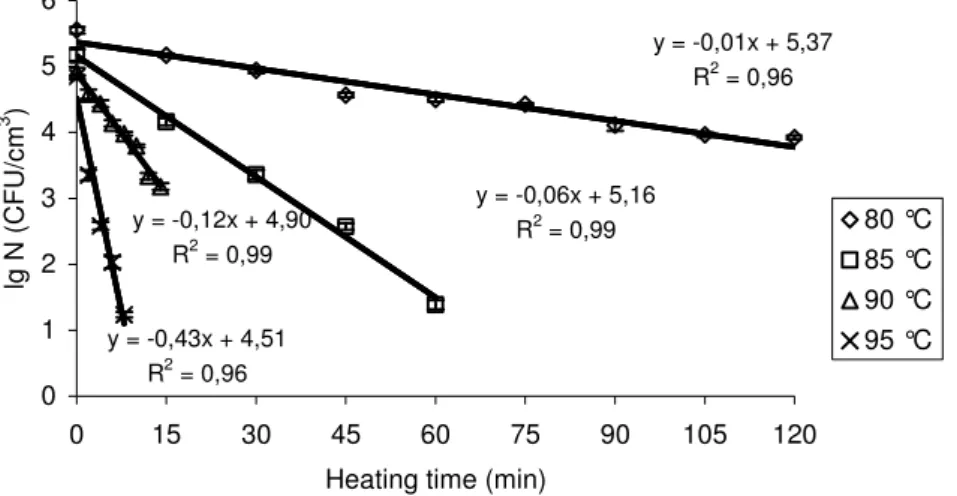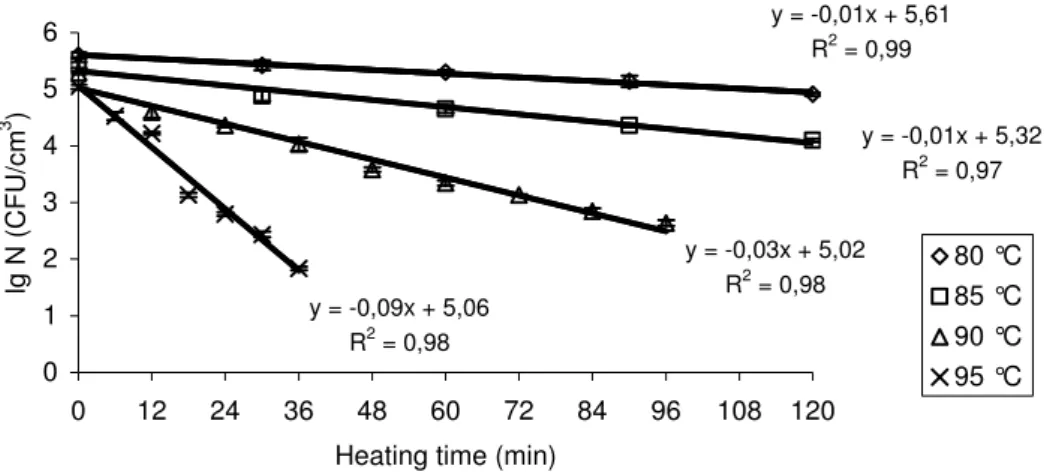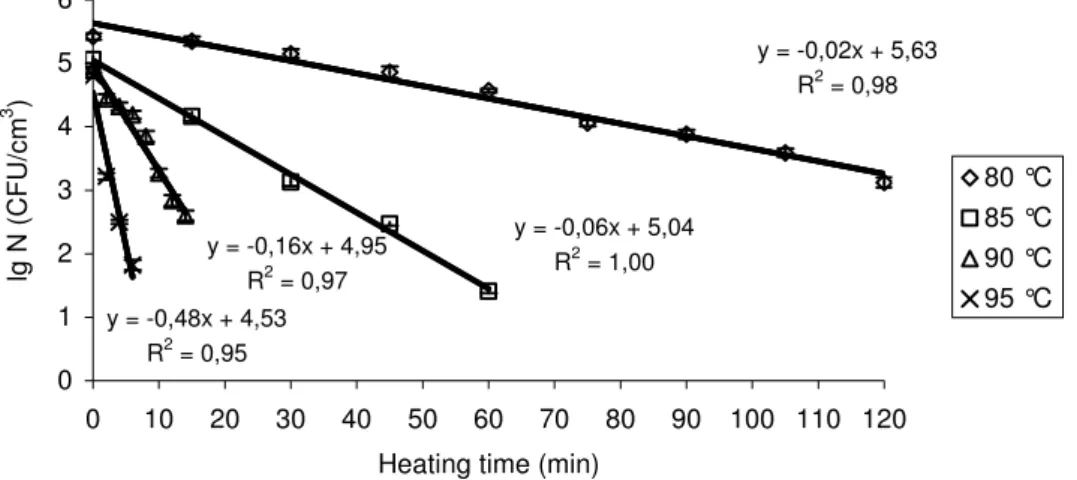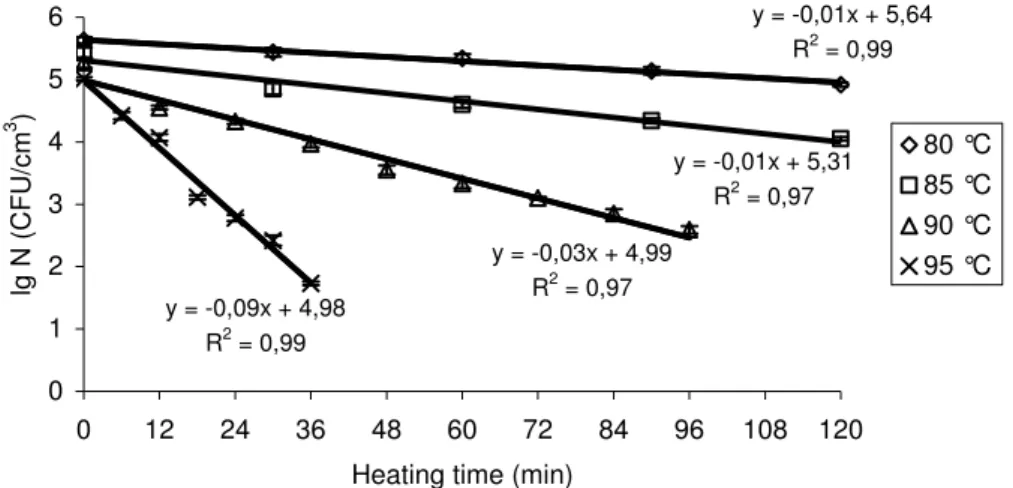THESES OF DOCTORAL (PHD) DISSERTATION
UNIVERSITY OF WEST HUNGARY
FACULTY OF AGRICULTURAL AND FOOD SCIENCES INSTITUTE OF FOOD SCIENCE
IMRE UJHELYI DOCTORAL SCHOOL OF ANIMAL SCIENCES
Head of Doctoral School:
Prof. Dr. Pál Benedek DSc
“Processing and Quality Assurance of Products of Animal Origin” Program
Doctoral Program Head:
Prof. Dr. habil. Jen ı Szigeti CSc
Dissertation Advisers:
Prof. Dr. habil. Jen ı Szigeti CSc Dr. Balázs Ásványi PhD
OPTIMIZATION OF HEAT TREATMENT PARAMETERS FOR DUCK LIVER PRODUCTS
Written by:
ZSÓFIA KOZMA-SIPOS
1. INTRODUCTIONANDAIMS Introduction
In this research, heat resistance of Clostridium (C.) perfringens and Clostridium sordellii spores and that of Enterococcus (Ec.) faecalis vegetative cells were tested at different temperatures. Occurring in raw waterfowl livers, C. perfringens and C. sordellii have a major effect on the shelf life of canned liver products, whereas Ec. faecalis is an indicator organism limiting the shelf life of semi-preserved foods. Based on the results obtained, a technology of manufacture for a specially flavored semi- preserved duck liver product has been developed.
Aims
1. Determining the microbiological properties of raw duck livers and comparing them to the criteria contained in Decree No. 4/1998 EüM (in effect as of November 6, 2007) on the acceptable levels of microbiological contamination in foods.
2. Identifying, on the basis of literature reports and own studies, the most heat resistant microorganisms in raw duck liver, and determining their occurrence.
3. Testing the suitability of various broths for promotion of sporulation by two strains of Clostridium perfringens (NCAIM B.01417 and NCTC 1265) and Clostridium sordellii ATCC 9714, and for growth stimulation of Enterococcus faecalis HNCMB 80171. As a result of sporulation trials, finding a C. perfringens strain capable of producing large amounts of spores.
4. Determining, based on the results of preliminary studies, the
of Ec. faecalis, being one of the most heat resistant non-spore-forming microbes, and Clostridium species.
5. Developing a technology of manufacture for a semi-preserved duck liver product that is potentially competitive on both domestic and international markets.
6. Doing heat destruction trials using a semi-preserved duck liver product spiked with clostridia and enterococci.
2. MATERIALSANDMETHODS
The trials were carried out in the Microbiological Laboratory of the Institute of Food Science at the Faculty of Agricultural and Food Sciences of the University of West Hungary. The Laboratory has been accredited by the German Accreditation Council since 1996.
2.1.Testing the microbiological quality of raw duck livers
Liver samples of 20 Mulard ducks were obtained from Hungarian duck farms. The results of microbiological examinations were compared to the criteria contained in Decree No. 4/1998 EüM on the acceptable levels of microbiological contamination in foods (Table 1).
Table 1 Microbiological reference criteria for internal inspection of meat products contained in Decree No. 4/1998 EüM
Product group Microorganism n c m M
Raw meat and meat products Minced meat, chitterlings, ground meat, poultry (raw, whole and minced)
Salmonella Staphylococcus aureus
Escherichia coli Total plate count
5 5 5 5
- 2 2 3
- 102 50/g
106
0/25g 103 5×102
107 n: number of sample units to be examined
c: maximum allowable number of defective sample units
m: expressed in CFU/g, it represents an acceptable level and values above it are marginally acceptable or unacceptable in terms of the sampling plan
M: expressed in CFU/g, unless otherwise stated, it is a microbiological criterion which separates (marginally) acceptable quality from defective quality
The following examinations were performed: detection of Salmonella spp., enumeration of aerobic mesophilic microorganisms, Staphylococcus aureus, Escherichia coli, mesophilic sulfite-reducing clostridia (including C.
perfringens and C. sordellii), and enterococci such as Ec. faecalis and Ec.
faecium.
2.2.Induction of sporulation
The freeze-dried cultures of Clostridium perfringens NCAIM B.01417, C. perfringens NCTC 1265, and C. sordellii ATCC 9714 were obtained in vacuum sealed vials. They were incubated anaerobically at 37±1
°C for 7 days in Reinforced Clostridial Medium (RCM; Merck KGaA, Darmstadt, Germany), and then a concentrated suspension was produced by centrifugation in sterile 30-cm3 tubes using a Sigma 3K12 centrifuge (Sigma Laborzentrifugen GmbH, Osterode, Germany) at 4500 × g for 15 min at 10°C. The supernatant was removed, and a pure suspension was prepared by dilution with quarter-strength Ringer’s solution.
The freeze-dried Ec. faecalis HNCMB 80171 was sub-cultured in 10 cm3 of brain-heart infusion broth (Merck) incubated under aerobic conditions at 37±1 °C for 2 days.
Sporulation broths proposed by Ellner (1956), Kim et al. (1967) and Duncan and Strong (1968) were used to promote sporulation of the tested strains of C. perfringens (NCAIM B.01417 and NCTC 1265).
In addition to the aforementioned culture broths, a special sporulation broth developed by Schaeffer et al. (1963) was also used for induction of sporulation by C. sordellii 9714.
10 cm3 of suspension obtained after centrifugation was added to each sporulation broth (100 cm3). Incubation took 3 days at 37±1 °C under anaerobic conditions, followed by refrigerated storage at 4±3 °C for 1 day.
Initial spore counts were then enumerated in samples heated at 80 °C for 10 min and then plated on Plate Count (PC) Agars (Merck).
2.3.Heat resistance trials in suspensions
Each of 10 cm3 C. sordellii ATCC 9714 and C. perfringens NCTC 1265 spore suspensions in test tubes were placed in a water bath (Gesellschaft für Labortechnik mbH, Burgwedel, Germany) set at 80 °C, 85
°C, 90 °C, or 95 °C and kept for 120 min, 120 min, 96 min, and 36 min (C.
sordellii) and 120 min, 60 min, 14 min, and 8 min (C. perfringens), respectively. Depending on the inactivation temperature and holding time, samples were collected at 2-min to 30-min intervals. After removal, the samples were immediately immersed into an ice-water-bath, and the spore counts of heat-treated suspensions were determined by the pour-plate technique using Plate Count agar (Merck) incubated at 37±1 °C for 3 days under anaerobic conditions.
The thermal inactivation trials on Ec. faecalis HNCMB 80171 were done at 60 °C to 70 °C. Reduced temperatures were used in this case because endospores are not supposed to be inactivated in semi-preserved products.
The Ec. faecalis cell suspensions were placed in a water bath set at 60 °C, 62
°C, 65 °C and 70 °C and kept for 60 min, 25 min, 5 min, and 5 min, respectively. Depending on the heating temperature and holding time, samples were taken every 0.5 min to 10 min. The cell counts of heat-treated suspensions were determined by the spread plate technique using Citrate Azide Tween Carbonate (CATC) agar (Merck) incubated at 37±1 °C for 48 h. The number of replicate samples was two and the experimental program was repeated three times.
2.4.Heat resistance trials in semi-preserved duck liver products
The author took part in developing a technology of manufacture for a semi-preserved duck liver product, which is already available on the market.
One of the major demands for Hungarian semi-preserved liver products is to have sensory properties similar to those of their French counterparts, which will result in improved competitiveness. 200-g and 400-g units were produced in an attempt to comply with the demands set by both households and restaurants. The 200-g product was subjected to thermal treatment at 105
°C for 35 min, which was enough to kill enterococci; however, such heating also caused undesirable changes in the sensory properties of the product. For this reason, the inactivation temperature had to be lowered below 100 °C.
The 400-g product was treated at 62 °C for 120 min.
The semi-preserved duck liver products thus produced were spiked with spore suspensions of C. sordellii ATCC 9714 and C. perfringens NTCT 1265 and cell suspensions of Ec. faecalis HNCMB 80171. The objective of the trials was to determine the holding time needed to result in a 2-log10
reduction in spore counts of C. perfringens NCTC 1265 and C. sordellii ATCC 9714 at 80 °C to 95 °C and in cell numbers of Ec. faecalis HNCMB 80171 at 60 °C to 65 °C in a real food sample. The heat resistance trials were carried out according to the procedures described in subchapter 2.3. The core temperature of the product was measured at 0.5-min intervals using a Testo type two-channel temperature recording system. The number of replicate samples was two and the experimental program was repeated three times.
3. RESULTSANDDISCUSSION
3.1.Microbiological quality of raw duck livers
The microbiological quality of raw duck livers was good but not perfect. None of the samples tested had total plate counts exceeding the regulatory limits laid down in Decree No. 4/1998 EüM. As for E. coli and S.
aureus, two and three samples, respectively, had viable counts between the values of m and M. All things considered, liver quality was good indeed. In addition to the examinations required by Decree No. 4/1998 EüM, the following microorganisms were enumerated: mesophilic sulfite-reducing clostridia, including C. perfringens and C. sordellii, and enterococci such as Ec. faecalis and Ec. faecium. Mesophilic sulfite-reducing clostridia were present in 13 samples. All these 13 samples were positive for C. perfringens and negative for C. sordellii. None of the raw duck liver samples surveyed contained detectable levels (<1.0×101 CFU/g) of Ec. faecalis or Ec. faecium.
3.2.Sporulation trials with clostridia
Both C. perfringens strains (NCAIM B.01417 and NCTC 1265) produced significantly higher (P < 0.05) spore counts in the broth proposed by Duncan and Strong (1968) than in the sporulation media developed by Ellner (1956) and Kim et al. (1967), and NCTC 1265 proved to be superior to NCAIM B.01417 in this respect. By contrast, these three culture broths were completely unsuitable for induction of sporulation by C. sordellii ATCC 9714. However, the sporulation broth developed by Schaeffer et al. (1963) resulted in a spore number of 4.1×105 CFU/cm3, which was a high enough count to work with effectively in the thermal inactivation trials.
3.3.Heat resistance trials in suspensions
The effects of thermal treatments on spore and cell counts of the strains tested (i.e., C. perfringens NCTC 1265, C. sordellii ATCC 9714, and Ec. faecalis HNCMB 80171) are shown in Figs 1 to 3.
y = -0,12x + 4,90 R2 = 0,99
y = -0,01x + 5,37 R2 = 0,96
y = -0,06x + 5,16 R2 = 0,99
y = -0,43x + 4,51 R2 = 0,96 0
1 2 3 4 5 6
0 15 30 45 60 75 90 105 120
Heating time (min) lg N (CFU/cm3 )
80 °C 85 °C 90 °C 95 °C
Fig. 1 Survival curves of Clostridium perfringens NCTC 1265 at 80 °C, 85 °C, 90 °C, and 95 °C. Whiskers indicate standard deviations calculated
from six observations (two samples, three replicates)
y = -0,01x + 5,32 R2 = 0,97
y = -0,03x + 5,02 R2 = 0,98
y = -0,01x + 5,61 R2 = 0,99
y = -0,09x + 5,06 R2 = 0,98 0
1 2 3 4 5 6
0 12 24 36 48 60 72 84 96 108 120
Heating time (min) lg N (CFU/cm3 )
80 °C 85 °C 90 °C 95 °C
Fig. 2 Survival curves of Clostridium sordellii ATCC 9714 at 80 °C, 85 °C, 90 °C, and 95 °C. Whiskers indicate standard deviations calculated from six
observations (two samples, three replicates)
y = -0,44x + 3,12 R2 = 0,99
y = -0,14x + 4,81 R2 = 0,98
y = -0,06x + 5,40 R2 = 0,93
0 1 2 3 4 5 6 7
0 5 10 15 20 25 30 35 40 45 50 55 60 Heating time (min)
lg N (CFU/cm3 )
60 °C 62 °C 65 °C
Fig. 3 Survival curves of Enterococcus faecalis HNCMB 80171 at 60 °C, 62 °C, and 65 °C. Whiskers indicate standard deviations calculated from six
observations (two samples, three replicates)
Decimal reduction times (D values) were calculated by taking the reciprocal of the slope from linear regression of the survival curves. The D
values for C. perfringens NCTC 1265 and C. sordellii ATCC 9714 spores ranged from 75.2 min for D80 (the D value for spore suspensions treated at 80°C) to 2.3 min for D95, and from 181.8 min (D80) to 11.0 min (D95), respectively. The D value of Ec. faecalis HNCMB 80171 was 15.7 min at 60 °C and 2.3 min at 65 °C.
3.4.Heat resistance trials in semi-preserved duck liver products
Figs 4 to 6 illustrate the influence of heat treatments on spore counts of C. perfringens NCTC 1265 and C. sordellii ATCC 9714 and on viable cell counts of Ec. faecalis HNCMB 80171 in semi-preserved duck livers.
y = -0,02x + 5,63 R2 = 0,98
y = -0,06x + 5,04 R2 = 1,00 y = -0,48x + 4,53
R2 = 0,95
y = -0,16x + 4,95 R2 = 0,97
0 1 2 3 4 5 6
0 10 20 30 40 50 60 70 80 90 100 110 120 Heating time (min)
lg N (CFU/cm3 )
80 °C 85 °C 90 °C 95 °C
Fig. 4 Survival curves of Clostridium perfringens NCTC 1265 in semi- preserved duck liver. Whiskers indicate standard deviations calculated from
six observations (two samples, three replicates)
y = -0,01x + 5,64 R2 = 0,99
y = -0,01x + 5,31 R2 = 0,97 y = -0,03x + 4,99
R2 = 0,97 y = -0,09x + 4,98
R2 = 0,99 0
1 2 3 4 5 6
0 12 24 36 48 60 72 84 96 108 120
Heating time (min) lg N (CFU/cm3 )
80 °C 85 °C 90 °C 95 °C
Fig. 5 Survival curves of Clostridium sordellii ATCC 9714 in semi-preserved duck liver. Whiskers indicate standard deviations calculated from six
observations (two samples, three replicates)
y = -0,04x + 4,80 R2 = 0,93
y = -0,11x + 4,77 R2 = 0,99 y = -0,33x + 3,21
R2 = 0,95 0
1 2 3 4 5 6
0 5 10 15 20 25 30 35 40 45 50 55 60
Heating time (min) lg N (CFU/cm3 )
60 °C 65 °C 62 °C
Fig. 6 Survival curves of Enterococcus faecalis HNCMB 80171 in semi- preserved duck liver. Whiskers indicate standard deviations calculated from
six observations (two samples, three replicates)
In semi-preserved duck liver, the D values for C. perfringens NCTC
min (D95) and from 175.4 min (D80) to 11.1 min (D95), respectively. The D value of Ec. faecalis HNCMB 80171 was 25.9 min at 60 °C and 3.1 min at 65 °C in duck liver.
In conclusion, the media in which the clostridia and enterococci were found (i.e., culture broth vs duck liver) had no significant influence (P >
0.05) on the effectiveness of thermal inactivation processes.
4. NEWSCIENTIFICFINDINGS
Based on the results outlined in the preceding chapter, the novel scientific findings of this research can be summarized as follows.
1. The current microbiological grading system of domestic raw waterfowl livers is unsatisfactory in terms of providing good quality raw material for the manufacture of semi-preserved products. The range of microorganisms to be tested should include anaerobic sporeformers, and the samples for such examinations should be collected in accordance with the instructions detailed in German Standard No. ASU L 00.00-20 for the detection of Salmonella spp.
2. The Clostridium perfringens strains tested (i.e., NCAIM B.01417 and NCTC 1265) produced significantly higher (P < 0.05) spore counts in the broth proposed by Duncan and Strong (1968) than in the sporulation media developed by Ellner (1956) and Kim et al. (1967). For promotion of sporulation by Clostridium sordellii ATCC 9714, the sporulation broth developed by Schaeffer et al. (1963) produced the best results.
3. For lack of literature data, thermal treatments below 100°C resulting in destruction of Clostridium sordellii ATCC 9714 in waterfowl products were established. It was determined that 76.0 min and 22.2 min were required at 90 °C and 95 °C, respectively, to reduce the spore counts of this strain by 2 log10 cycles, which was necessary for the manufacture of safe liver products. According to the literature, a similar degree of reduction in spore counts of Clostridium botulinum E is attainable with such a heat treatment. The Z value for Clostridium sordellii ATCC 9714 was calculated to be as high as 12.6 °C.
4. The decimal reduction times for Clostridium perfringens NCTC 1265 in semi-preserved duck liver ranged from 50.5 min (D80) to 2.2 min (D95).
These D values are somewhat lower than those published in the literature. The Z value of Clostridium perfringens NCTC 1265 was calculated to be 11.1 °C. Other authors reported Z values ranging between 8.3 °C and 16.8 °C.
5. The media (i.e., culture broth and semi-preserved duck liver) spiked with the tested strains of Clostridium perfringens, Clostridium sordellii, or Enterococcus faecalis had no significant influence (P > 0.05) on the effectiveness of thermal inactivation processes.
5. SCIENTIFIC PAPERS PUBLISHED IN THE TOPIC OF THE DISSERTATION
PEER REVIEWED PAPERS In English
Zs. Sipos-Kozma, J. Szigeti, L. Varga, B. Ásványi, N. Ásványi-Molnár, Zs.
Turcsán (2008) Determining the parameters of mild heat treatment destroying Clostridium perfringens. Hungarian Agricultural Engineering 21, 70-72.
Zs. Kozma-Sipos, J. Szigeti, B. Ásványi, L. Varga (2010) Heat resistance of Clostridium sordellii spores. Anaerobe (submitted for publication).
In Hungarian
Sipos-Kozma, Zs., Ásványi, B., Szigeti, J., Varga, L. (2009) Spórás baktériumok hıpusztulása 100 °C alatti hıkezelés esetében. Acta Agronomica Óváriensis (accepted for publication).
Sipos-Kozma Zs., Szigeti, J., Varga, L., Ásványi, B. (2009) Clostridium perfringens spórák hıtőrésének vizsgálata. Acta Agraria Kaposváriensis (accepted for publication).
PAPERS PUBLISHED IN PROCEEDINGS OF CONFERENCES In English
Sipos-Kozma, Zs., Szigeti, J., Ásványi, B. (2008) Reducing spore counts in foods by mild heat treatment. International Conference on Science and Technique in the Agri-Food Business (ICoSTAF 2008), ISBN 978-963-482-908-9, November 5-6, 2008 Szeged pp. 170-176.
In Hungarian
Szigeti, J., Varga, L., Ásványi, B., Sipos-Kozma, Zs. (2008) Élelmiszerekben elıforduló anaerob spórások kíméletes hıkezelése. XXXII. Óvári Tudományos Nap “Élelmiszer-gazdaságunk kérdıjelei napjainkban – Dr. Dr. h. c. Iváncsics János (1938-2002) születésének 70. évfordulója tiszteletére”. Az elıadások és poszterek teljes terjedelemben megjelent anyagai, ISBN 978-963-9883-05-5.
Nyugat-magyarországi Egyetem, Mezıgazdaság- és Élelmiszer-tudományi Kar, Mosonmagyaróvár, Compact Disc, 6 pp.




